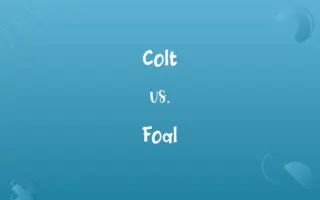HTML vs. XML: What's the Difference?
Edited by Janet White || By Harlon Moss || Updated on October 19, 2023
HTML is for displaying web content, while XML is for carrying data.

Key Differences
HTML, standing for HyperText Markup Language, is the standard markup language for creating web pages and web applications. XML, which stands for eXtensible Markup Language, is a markup language designed to store and transport data. Unlike HTML which focuses on how to present content, XML emphasizes what the content is.
HTML has a predefined set of tags that dictate the appearance and layout of content on a web page. On the other hand, XML allows users to define their tags, ensuring the data is self-descriptive. The tags in HTML are not flexible, and there is a set way in which they should be used. XML, however, is flexible and can be designed to carry data, not just for web pages but for a multitude of applications.
HTML is mainly used in web development for building web pages. Its tags are used to structure the content on the web page, integrating texts, images, and other multimedia elements. XML, in contrast, is utilized across various platforms and applications as a way to transport and store data. It doesn't have a specific look or design like HTML, but rather, it describes the data's structure.
Both HTML and XML have similar syntax characteristics, such as the use of tags and attributes. However, HTML is more lenient when it comes to syntax errors, often still rendering the content even with mistakes. XML is strict and will not process files with errors, emphasizing the correctness of the data structure.
Comparison Chart
Purpose
Displaying web content
Carrying data
ADVERTISEMENT
Predefined Tags
Yes, specific tags for web content
No, users can define their own tags
Flexibility
Less flexible, specific to web presentation
Highly flexible, used across various applications
Error Handling
More lenient with syntax errors
Strict, will not process files with errors
Design vs. Data
Focuses on how content looks
Focuses on what the data is
HTML and XML Definitions
Html
HTML uses tags to structure and present content.
He added an HTML tag to emphasize the text.
ADVERTISEMENT
XML
XML allows users to define their tags.
She created custom XML tags for her application.
Html
HTML is the standard language for creating web pages.
HTML allows designers to structure content on web pages.
XML
XML stands for eXtensible Markup Language.
He transported data using XML format.
Html
HTML stands for HyperText Markup Language.
She coded the website using HTML.
XML
XML is designed to carry and transport data.
XML ensures data integrity during transportation.
Html
HTML integrates text, images, and multimedia elements.
She embedded a video using HTML code.
XML
XML emphasizes data structure over design.
The XML file described the data hierarchy clearly.
Html
HTML provides the visual structure for web browsers.
Browsers interpret HTML to display web content.
XML
XML requires strict syntax and error handling.
The XML file wouldn't process due to a syntax error.
Html
A markup language used to structure text and multimedia documents and to set up hypertext links between documents, used extensively on the World Wide Web.
XML
An international standard metalanguage for creating markup languages that structure digital information in a way that allows for the exchange, display, and storage of data independent of proprietary operating systems and hardware devices.
Html
A set of tags and rules (conforming to SGML) for using them in developing hypertext documents
FAQs
How does XML differ from HTML in purpose?
XML is designed to carry and transport data, while HTML is for displaying content.
Are XML tags predefined like HTML?
No, XML allows users to define their tags.
What is the main purpose of HTML?
HTML is used for creating and displaying web content.
How does error handling in XML differ from HTML?
XML is strict and won't process files with errors, whereas HTML is more lenient.
Is HTML strict about syntax errors?
No, HTML is more lenient with syntax errors compared to XML.
Can XML describe data's appearance?
No, XML focuses on describing data's structure, not its appearance.
Why would one use XML over HTML?
For transporting and storing data in a structured format.
What does HTML stand for?
HTML stands for HyperText Markup Language.
What does XML stand for?
XML stands for eXtensible Markup Language.
Do both HTML and XML use tags and attributes?
Yes, both languages use tags and attributes in their structure.
Is HTML limited to web applications?
Mostly, as HTML is designed for web content presentation.
Can I use both HTML and XML together?
Yes, for example, XML can be used to transport data that can be displayed using HTML.
Which is older, HTML or XML?
HTML is older, originating in the late 1980s, while XML was developed in the late 1990s.
Can I use XML to design websites?
XML is primarily for data, not design. You'd use HTML for web design.
Can I embed multimedia elements using XML?
XML carries data. Multimedia embedding is a function of HTML.
How do web browsers interpret HTML and XML?
Browsers display content using HTML. XML data might be processed or displayed based on its purpose.
Is XML dependent on a specific platform or software?
No, XML is platform-independent.
Can I use XML for applications other than web?
Yes, XML is versatile and can be used across various platforms and applications.
Are HTML tags flexible?
No, HTML has a predefined set of tags for web content.
Which is more flexible, HTML or XML?
XML is more flexible as it allows custom tag definitions.
About Author
Written by
Harlon MossHarlon is a seasoned quality moderator and accomplished content writer for Difference Wiki. An alumnus of the prestigious University of California, he earned his degree in Computer Science. Leveraging his academic background, Harlon brings a meticulous and informed perspective to his work, ensuring content accuracy and excellence.
Edited by
Janet WhiteJanet White has been an esteemed writer and blogger for Difference Wiki. Holding a Master's degree in Science and Medical Journalism from the prestigious Boston University, she has consistently demonstrated her expertise and passion for her field. When she's not immersed in her work, Janet relishes her time exercising, delving into a good book, and cherishing moments with friends and family.







































































